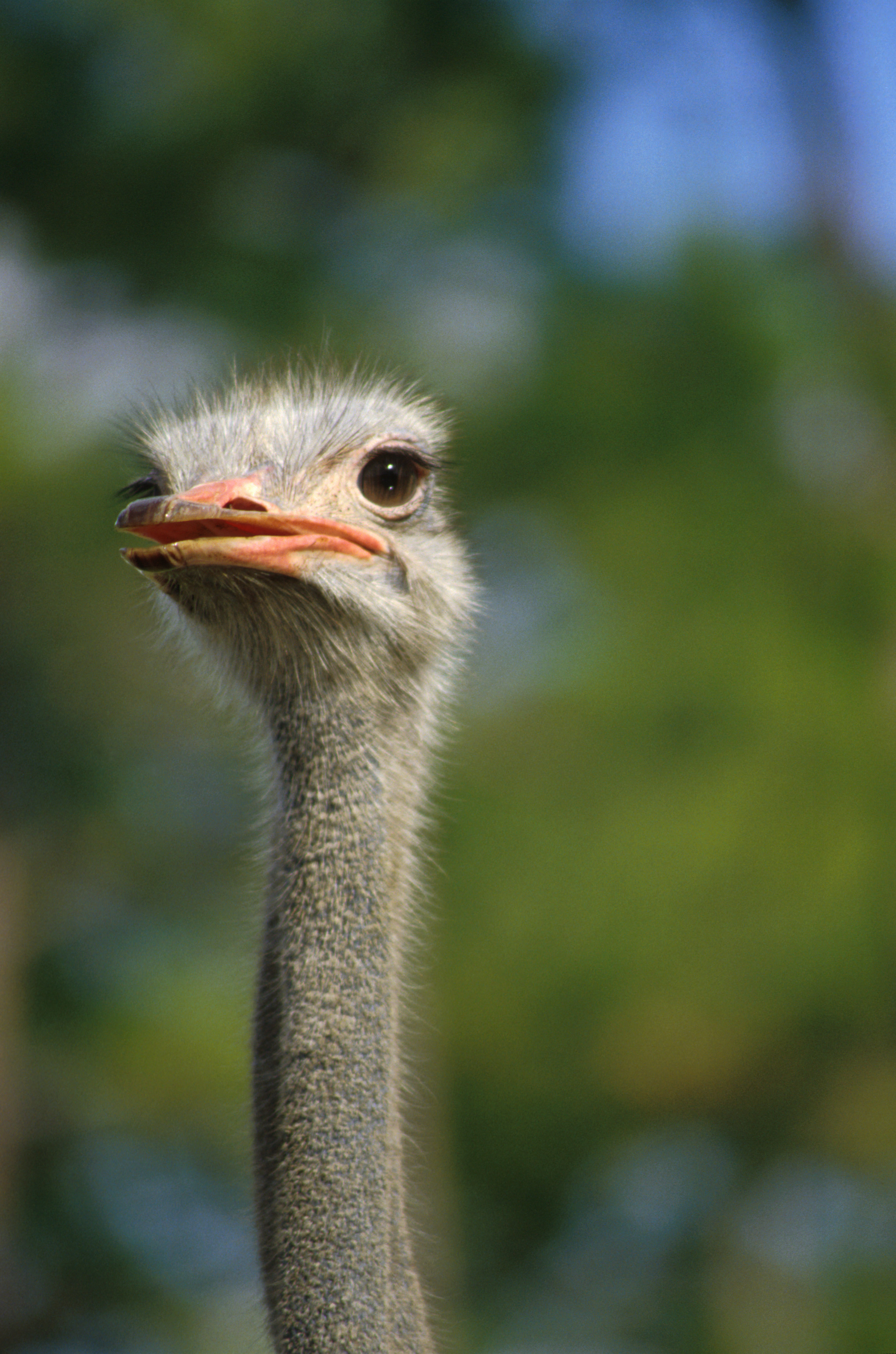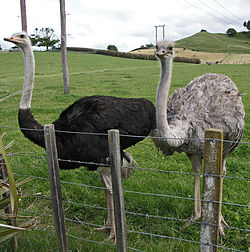Common ostrich
| Ostrich | |
|---|---|
| File:Ostrich Tanzania.jpg | |
| Scientific classification | |
| Kingdom: | |
| Phylum: | |
| Class: | |
| Order: | |
| Family: | Struthionidae Vigors, 1825
|
| Genus: | Struthio
|
| Species: | S. camelus
|
| Binomial name | |
| Struthio camelus | |
The ostrich (Struthio camelus) is a flightless bird native to Africa. It is the only living species of its family, Struthionidae, and its genus, Struthio. They are distinct in their appearance, with a long neck and legs and the ability to run at speeds of about 65 km/h (40 mph). Ostriches are considered the largest living species of bird and are farmed all over the world. The scientific name for the ostrich is from the Greek for "sparrow camel."
Description
Ostriches usually weigh from 90 to 130 kg (200 to 290 pounds), although some male ostriches have been recorded with weights of up to 155 kg (340 pounds). The feathers of adult males are mostly black, with some white on the wings and tail. Females and young males are grayish-brown, with a bit of white. The small vestigial wings are used by males in mating displays. They can also provide shade for chicks. The feathers are soft and serve as insulation, and are quite different from the stiff airfoil feathers of flying birds. There are claws on two of the wings' fingers. The strong legs of the ostrich lack feathers. The bird stands on two toes, with the bigger one resembling a hoof. This is an adaptation unique to ostriches that appears to aid in running. The eyes of ostriches with their thick black eyelashes are the biggest eyes of all living land animals.
At sexual maturity (two to four years old), male ostriches can be between 1.8 m and 2.7 m (6 feet and 9 feet) in height, while female ostriches range from 1.7 m to 2 m (5.5 ft to 6.5 ft). During the first year of life, chicks grow about 25 cm (10 inches) per month. At one year, ostriches weigh around 45 kg (100 pounds).
Classification and distribution


Ostriches occur naturally on the savannas and Sahel of Africa, both north and south of the equatorial forest zone. The species belong to the Struthioniformes order (ratites). Other members of this group include rheas, emus, cassowaries and the largest bird ever, the now-extinct Aepyornis. Five subspecies are recognized:
- S.c. australis in Southern Africa
- S.c. camelus in North Africa, sometimes called the North African ostrich or red-necked ostrich.
- S.c. massaicus in East Africa, sometimes called the Masai ostrich. During the mating season, the male's neck and thighs turn pink-orange. Their range is from Ethiopia and Kenya in the east to Senegal in the west, and from eastern Mauritania in the north to southern Morocco in the south.
- S.c. molybdophanes in Somalia, Ethiopia, and northern Kenya, sometimes called the Somali ostrich. During the mating season, the male's neck and thighs turn blue. Its range overlaps with S.c. massaicus in northeastern Kenya. Some authorities consider the Somali Ostrich a full species.
- S.c. syriacus in the Middle East, sometimes called the Arabian ostrich or Middle Eastern ostrich, was a subspecies formerly very common in the Arabian Peninsula, Syria, and Iraq; it became extinct around 1966.
Behavior
Ostriches live in nomadic groups of 5 to 50 birds that often travel together with other grazing animals, such as zebras or antelopes. They mainly feed on seeds and other plant matter; occasionally they also eat insects such as locusts. Lacking teeth, they swallow pebbles that help to grind the swallowed foods in the gizzard. They can go without water for a long time, exclusively living off the moisture in the ingested plants. However, they enjoy water and frequently take baths.
With their acute eyesight and hearing, they can sense predators such as lions from far away.
In popular mythology, the ostrich is famous for hiding its head in the sand at the first sign of danger. The Roman writer Pliny the Elder is noted for his descriptions of the ostrich in his Naturalis Historia, where he describes the ostrich and the fact that it hides its head in a bush. There have been no recorded observations of this behavior. A common counter-argument is that a species that displayed this behavior would not likely survive very long. The myth may have resulted from the fact that, from a distance, when ostriches feed they appear to be burying their head in the sand because they deliberately swallow sand and pebbles to help grind up their food. Burying their heads in sand will in fact suffocate the ostrich. When lying down and hiding from predators, the birds are known to lay their head and neck flat on the ground, making them appear as a mound of earth from a distance. This even works for the males, as they hold wings and tail low, the heat haze of the hot, dry air that often occurs in their habitat aiding to make them appear as a nondescript dark lump. When threatened, ostriches run away, but they can also seriously injure with kicks from their powerful legs.
The ostrich's behavior is also mentioned in what is thought to be the most ancient book of the Bible in God's discourse to Job (Job 39.13-18)and is described as joyfully proud of its small wings, unmindful of the safety of its nest, a bird that treats her offspring harshly, that lacks in wisdom, and yet can put a horse to shame with its speed.
Reproduction


Ostriches become sexually mature when 2 to 4 years old; females mature about six months earlier than males. The species is iteroparous, with the mating season beginning in March or April and ending sometime before September. The mating process differs in different geographical regions. Territorial males will typically use hisses and other sounds to fight for a harem of 2 to 5 females (which are called hens). The winner of these fights will breed with all the females in an area but only form a pair bond with one, the dominant female. The female cowers on the ground and is mounted from behind by the male.
Ostriches are oviparous. The females will lay their fertilized eggs in a single communal nest, a simple pit scraped in the ground and 30 to 60 cm deep. Ostrich eggs can weigh 1.3 kg and are the largest of all eggs (and the largest single cells), though they are actually the smallest eggs relative to the size of the bird. The nest may contain 15 to 60 eggs, with an average egg being 6 inches (15 cm) long, 5 inches (13 cm) wide, and weigh 3 pounds (1.4 kg). They are shiny and whitish in color. The eggs are incubated by the females by day and by the male by night, making use of the different colors of the two sexes to escape detection. The gestation period is 35 to 45 days. Typically, the male will tend to the hatchlings.
The life span can extend from 30 to 70 years, with 50 being typical.
Ostriches and humans



In the past, ostriches were mostly hunted and farmed for their feathers, which used to be very popular as ornaments in ladies' hats and such. Their skins were also valued to make a fine leather. In the 18th century, they were almost hunted to extinction; farming for feathers began in the 19th century. The market for feathers collapsed after World War I, but commercial farming for feathers and later for skins, took off during the 1970s.
The ostriches in Arabia and Southwest Asia were hunted to extinction by the middle of the 20th century.
Today, ostriches are bred all over the world, including climates as cold as that of Sweden. They will prosper in climates between 30 and −10 °C, and are farmed in over 50 countries around the world, but the majority are still found in Southern Africa. Since they also have the best feed to weight ratio gain of any land animal (3.5:1 whereas that of cattle is 6:1) in the world, they are bound to appear attractive to farmers. Although they are farmed primarily for leather and secondarily for meat, additional useful byproducts are the eggs, offal, and feathers. It is claimed that ostriches produce the strongest commercially available leather1. Ostrich meat tastes similar to lean beef and is low in fat and cholesterol, as well as high in calcium, protein and iron. [1]
Ostriches are large enough for a small human to ride them; typically, the human will hold on to the wings while riding. They have been trained in some areas of northern Africa and Arabia as racing mounts. Ostrich races in the United States have been criticized by animal rights organizations, however there is little possibility of this becoming a widespread practice due to the fact that the animals are difficult to saddle (and ostriches are known to have a rather irascible temper).
Ostriches are classified as dangerous animals in Australia, the US and the UK. There are a number of recorded incidents of people being attacked and killed. Big males can be very territorial and aggressive and can attack and kick very powerfully with their legs. An ostrich will easily outrun any human athlete. Their legs are powerfull enough to eviscerate large animals.
External links
- Photos of hatchlings and mating ostriches
- Animal Diversity Web
- Bird Families of the World
- Fleet-Footed, Flightless, and Fascinating — The Ostrich
- Ostrich facts - Wild Animals Online encyclopedia
- Ostrich videos on the Internet Bird Collection
